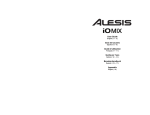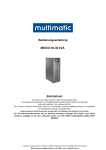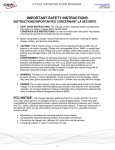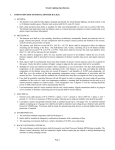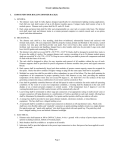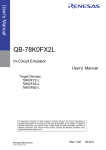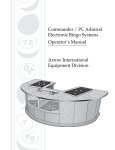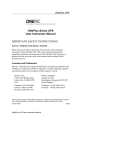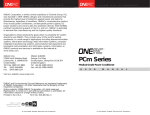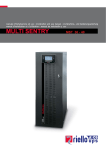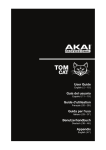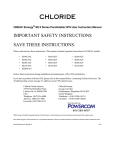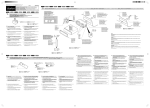Download 913298D CC_CCS Manual
Transcript
CC/CCS Power Conditioners User Instruction Manual CC/CCS Power Conditioners User Instruction Manual IMPORTANT SAFETY INSTRUCTIONS SAVE THESE INSTRUCTIONS. Please read and save these instructions. This manual contains important instructions for the Power Conditioner. Follow these instructions during the unpacking, installation and maintenance of the Power Conditioner. If you have a problem with the unit, please refer to this manual before calling ONEAC Technical Services. Licenses and Trademarks ONEAC and Environmental Reference Ground are registered trademarks of ONEAC Corporation. All other trademarks, product and corporate names are the property of their respective owners. ONEAC USA 27944 North Bradley Road Libertyville, IL 60048-9700 USA ONEAC EUROPE George Curl Way Southampton, Hampshire SO18 2RY United Kingdom Telephone: (847) 816-6000 Toll Free: (800) 327-8801 Facsimile: (847) 680-5124 Telephone: +44 (0) 2380 610311 Facsimile: +44 (0) 2380 649994 Entire contents copyright © 2006 ONEAC Corporation. All rights reserved. Reproduction in whole or in part without permission is prohibited. All information subject to change without notice. 913-298 Rev. D CC/CCS Power Conditioners User Instruction Manual 9/06 Contents Contents Introduction ...................................................................................................1 Registering Your Power Conditioner ............................................................1 Technical Support .........................................................................................1 What Equipment Needs Power Conditioning? ..........................................2 Sizing Information .....................................................................................2 Installation Overview ....................................................................................2 Important Installation Guidelines ..............................................................3 Verifying Your Installation ........................................................................4 Installation and Operation .............................................................................5 Unpacking and Placement .........................................................................5 Input Connections ......................................................................................6 Installation: Input Connections ..............................................................6 Cord-connected models .......................................................................6 Hardwire input connected models .......................................................7 Output Connections ...................................................................................8 Installation: Output Connections ...........................................................9 Receptacle Output Models ...................................................................9 Hardwire Output Connected Models .................................................10 Output Fuses ......................................................................................12 Use of the Environmental Reference Ground ......................................12 Specifications .............................................................................................14 CC AND CCS Series Specifications .......................................................15 Physical Views ............................................................................................16 Maintenance ................................................................................................17 Torque Specifications ..............................................................................17 Fuse Replacement ....................................................................................18 Voltage Tap Selection .................................................................................18 Selecting Voltage Tap ..............................................................................19 Troubleshooting an Installation ...................................................................23 Warranty ......................................................................................................24 Limitations of Warranty ..........................................................................24 Exclusive Remedies .................................................................................24 Return Procedure .....................................................................................25 CC/CCS Power Conditioner User Instruction Manual i Contents ii ON Series e UPS User Instruction Manual Introduction Introduction Thank you for selecting this ONEAC Power Conditioner. ONEAC’s Power Conditioners offer the most reliable protection available from the harmful effects of electrical line disturbances for your computing and communications equipment. ONEAC’s ISO 9001 certification represents our commitment to building world-class products. We take pride in every unit that leaves our manufacturing facility. Registering Your Power Conditioner To register your Power Conditioner, complete the warranty registration form on the ONEAC website at www.oneac.com. Technical Support ONEAC offers 24-hour technical support. To contact ONEAC Technical Services: • North America: (800) 327-8801 (opt. 3) or (847) 816-6000 (opt. 3) • Europe: +44 (0) 2380 610311 • email: [email protected]. NOTE: All calls received before 7 a.m. or after 7p.m. Central Standard Time are forwarded to a cell phone. An ONEAC Technical Support Representative will return your call within one half hour between 5 p.m. and 10 p.m. Central Standard Time. Except for emergencies, calls received between 10 p.m. and 7 a.m. will be returned during normal business hours. Please check with ONEAC Technical Services before attempting to repair or return any ONEAC product. If an ONEAC unit needs repair or replacement, ONEAC Technical Services issues a Return Material Authorization (RMA) number along with instructions on how to return the unit. WARNING: Dangerous voltages are present within this unit. There are no user serviceable parts within this unit; therefore, any repairs or modifications may result in out-of-warranty repair charges, unsafe electrical conditions, or violation of electrical code. CC/CCS Power Conditioner User Manual 1 Installation Overview WARNUNG: Dieses Leistungsanpassungsgerät führt lebensgefährliche Spannung. Stromschlaggefahr! Bitte beachten Sie die in Ihrem Land geltenden Vorschriften über die Verdrahtung und Beschaltung. What Equipment Needs Power Conditioning? Only your electronic based equipment requires conditioned power. Fans, air conditioners and motors do not require power conditioning. Placing fans, air conditioners, motors or other noise generators between the conditioner and the electronics introduces electrical interference into the already conditioned power. In order to minimize electrical noise, each piece of equipment should be individually wired back to the output of the ONEAC power conditioner. Sizing Information The rating label of your ONEAC power conditioner lists the model’s current rating, nominal input and output voltage and serial number. The combined steady state RMS current draw of all your equipment must not exceed the power conditioner’s output current rating. Installation Overview NOTE: Only qualified electricians should install an ONEAC power conditioner. Follow the U.S. National Electrical Code®, local codes, good wiring practice and this User Manual. 1. Unpack the power conditioner (see Unpacking and Placement on page 5). 2. Move the POWER CONDITIONER to the installation location. 3. Connect the input plug or conduit. On hardwire models, use a equipment grounding conductor that is equal or larger than the current carrying conductors (see Input Connections on page 6). 4. Turn on the power feed to the input. 5. Turn on the input circuit breaker. 2 CC/CCS Power Conditioner User Manual Installation Overview 6. Verify the correct operation of the power conditioner (see Verifying Your Installation on page 4). 7. Turn off the input circuit breaker. Connect your equipment to the output (see Output Connections on page 8). On hardwire units, the use steel or flexible wall conduit with a continuous copper ground is recommended. 8. Turn on the input circuit breaker. 9. Turn on your equipment. 10. Start normal operation of your system. Important Installation Guidelines Only qualified electricians should install or retrofit this ONEAC power conditioner. WARNING: This power conditioner contains dangerous voltages. Accidental contact can result in serious electrical shock. Always follow the US National Electrical Code or your local electrical codes and good wiring practice. WARNUNG: Dieses Leistungsanpassungsgerät führt lebensgefährliche Spannung. Stromschlaggefahr! Bitte beachten Sie die in Ihrem Land geltenden Vorschriften über die Verdrahtung und Beschaltung. This power conditioner is a single phase unit. The secondary is wired as a single phase or in some models, as a split phase output configuration as shown below. The input requires an equipment grounding conductor connection. The use of steel or CC/CCS Power Conditioner User Manual 3 Installation Overview flexible steel wall conduit is strongly preferred for hardwire models. Fig. 1: CC and CCS Power Conditioner Wiring Physically separate the input power connections to the power conditioner from the equipment power connections on the output. Data cables should be kept as far away as possible from any power cables. For maximum performance, use shielded cable or steel or flexible steel wall conduit with a continuous copper ground between your equipment and the power conditioner. Always include an equipment grounding conductor for each circuit on the output of the power conditioner. Do not use extension cords or power strips. Do not connect your equipment to the power conditioner’s output until the input connections have been made and proper power conditioner operation has been verified. Verifying Your Installation 1. Turn OFF the input circuit breaker on the power conditioner. Verify that the installation follows the guidelines outlined in Important Installation Guidelines on page 3. 2. Turn ON the main power source. WARNING: Dangerous voltages are present. WARNUNG: Stromführend. Ebensgefahr! 3. Place the power conditioner’s input circuit breaker in the ON position. 4. Use a voltmeter to determine if voltage is present at the input and output. The 4 CC/CCS Power Conditioner User Manual Installation and Operation ONEAC power conditioner’s output voltage may run a few volts higher than the rated value until the load is switched on. 5. If there is power at the input with no power at the output; • Turn OFF the main input circuit breaker. • Turn OFF the main power source supplying the power conditioner. • Follow the procedure in Troubleshooting an Installation on page 23. Installation and Operation Unpacking and Placement Your ONEAC power conditioner is delivered in a protective package. Upon arrival, inspect the unit and the package for signs of damage. If damage is detected, immediately contact the freight company and ONEAC Technical Services. You can reach ONEAC Technical Services at 1-800-327-8801, option 3 or at 1-847-816-6000. ONEAC recommends that your power conditioner be left in the package during handling. Remove the conditioner from the package once it is as close as possible to its final installation location. The actual physical placement of the power conditioner should be as close as possible to your equipment. The power conditioner should be installed inside the room containing your equipment. Allow at least 2 inches (5.0 cm) around all sides of the ONEAC power conditioner. Do not allow the conditioner to be installed where direct contact with water is possible. Once the location of your power conditioner has been determined, carefully remove the unit from the package and put it into place. CC/CCS Power Conditioner User Manual 5 Installation and Operation Input Connections The input connection for standard models is supplied as a NEMA plug on the end of a cord. Some models are available with a hardwire input connection. Hardwire models have a 1/2” (13 mm) conduit connection with internal terminal blocks enclosed within an attached wiring box. An additional hardwire version is available that utilizes a flat conduit landing plate attached to the rear of the unit that will accept 1/2 or 3/4 inch conduit. Your ONEAC cord-connected, CC and CCS Series power conditioners will meet your power conditioning requirements without the need for special grounds. Since the cord-connected power conditioner is considered as utilization equipment, a connection to the equipment grounding conductor that conforms to the U.S. National Electrical Code and your local electrical codes through the input cord and plug is all that is necessary. However, for hardwired units or if you wish to connect the secondary side grounded conductor (neutral) of the power conditioner to a grounding electrode system (local building steel, water pipes, made electrodes, etc.) you can do so by connecting a grounding electrode conductor to the #10-32 x 3/4 inch stud referred to as the Environmental Reference Ground®. This pressed-in stud is electrically referenced to the secondary side grounded conductor through an internal bonding jumper. Installation: Input Connections Cord-connected models 1. Use a voltmeter to determine if voltage is present in the branch circuit receptacle and confirm that it is the same value as specified on the power conditioner’s rating label. The receptacle should meet the requirements of the U.S. National Electrical Code and any local codes. 6 CC/CCS Power Conditioner User Manual Installation and Operation 2. With the ON/OFF switch in the OFF position, plug the conditioner into the receptacle at the power conditioner’s desired location. The conditioner should be as close as possible to your equipment. 3. Follow the procedure in the section Verifying Your Installation on page 4. 4. Turn the power conditioner OFF and refer to Installation: Output Connections. Hardwire input connected models 1. Wire in accordance with the U.S. National Electrical Code and your local codes. WARNING: Turn off the main power source supplying the power conditioner at the service disconnect before proceeding. WARNUNG: Vor dem nächsten Arbeitsschritt muß die Hauptnetzversorgung zum Leistungsanpassungsgerät am Wartungstrennschalter abgeschaltet werden. 2. For Model CCxx48 units, remove the unit cover to expose the input terminal connections. For all other CC and CCS Series, remove the cover on the rear panel to expose the input terminal connections. 3. Place the input conduit through the bottom or side knockout hole. 4. Connect the input equipment grounding conductor to the terminal block (G). Heavy gauge wire, equal to or larger in diameter than the power carrying conductors should be used to connect this safety ground. It is recommended that ground be wired back to the service ground. 5. Do not rely on the conduit alone for connection to ground. ONEAC discourages the down sizing of grounding conductors as allowed by various codes. If in doubt regarding wire sizing, consult the U.S. National Electrical Code, Table CC/CCS Power Conditioner User Manual 7 Installation and Operation 310-16, or your local electrical codes. CCxx48 Series All Other CC and CCS Series - Hardwire Fig. 2: CC and CCS Hardwire Connections 6. Connect the input phase wires to the input terminal block. Separate the input power cable to the ONEAC power conditioner from the equipment power cable. Data cables should be kept as far away from any power cables as possible. Torque all connections. Refer to the torque specifications in Maintenance on page 17. 7. Replace the unit or rear terminal cover. 8. Follow the procedure in the section Verifying Your Installation on page 4. Output Connections The output connections are supplied as various NEMA style receptacles. Some models are available with a hardwire output connection. Hardwire models have a 1/2” (13 mm) conduit connection with internal terminal blocks enclosed within an attached wiring box. An additional hardwire version is available that utilizes a flat conduit landing plate attached to the rear of the unit that will accept 1/2 or 3/4 inch conduit. Your ONEAC cord-connected, CC and CCS Series, power conditioners will meet your power conditioning requirements without the need for special grounds. Since the cord-connected power conditioner is considered 8 CC/CCS Power Conditioner User Manual Installation and Operation as utilization equipment, a connection to the equipment grounding conductor that conforms to the U.S. National Electrical Code and your local electrical codes through the input cord and plug is all that is necessary. However, for hardwired units or if you wish to connect the secondary side grounded conductor (neutral) of the power conditioner to a grounding electrode system (local building steel, water pipes, made electrodes, etc.) you can do so by connecting a grounding electrode conductor to the #10-32 x 3/4 inch stud referred to as the Environmental Reference Ground. This pressed-in stud is electrically referenced to the secondary side grounded conductor through an internal bonding jumper. The ONEAC power conditioner circuit breaker may be used as a central ON/OFF power switch. Some models have fused outputs to protect the ONEAC power conditioner from overload. Installation: Output Connections Receptacle output models 1. Follow the procedure for connecting the input connections, see Input Connections on page 6. 2. Each power run should be unique to each piece of equipment in the system. The use of temporary power taps should be avoided. Even the use of duplex receptacles should be avoided in the case of electrically noisy loads. Data cables should be kept as far away from any power cables as possible. 3. Separate the input power cable to the ONEAC power conditioner from the equipment power cable. ONEAC recommends that power runs on the output of the conditioner be as short as possible, with a maximum length of 50 feet (15 m). CC/CCS Power Conditioner User Manual 9 Installation and Operation 4. Use wire sizes as recommended by the National Electrical Code for lengths up to 25 feet (7.6m). For lengths from 30 feet (9.1m) up to 50 feet (15.2m) increase the NEC recommendations, for 60ºC insulation, by 2 wire sizes (i.e. 10 gauge rather than 12 gauge). 5. Torque all connections. Refer to the torque specifications in Maintenance on page 17. 6. Make sure there is an equipment grounding conductor connected between the receptacle on the ONEAC power conditioner output and your equipment. 7. Turn OFF the ONEAC power conditioner circuit breaker and your equipment. 8. Plug your equipment into the appropriate receptacle on the ONEAC power conditioner. The power conditioner should be as close as possible to your equipment. 9. Turn ON the ONEAC power conditioner and then your equipment. 10. Begin normal operation of your equipment. Hardwire output connected models 1. Follow the procedure for connecting the input connections, see Input Connections on page 6. 2. Follow the U.S. National Electrical Code and your local codes. WARNING: Turn off the main power source supplying the power conditioner at the service disconnect before proceeding. WARNUNG: Vor dem nächsten Arbeitsschritt muß die Hauptnetzversorgung zum Leistungsanpassungsgerät am Wartungstrennschalter abgeschaltet werden. 3. Remove the rear terminal box cover or rear conduit landing plate to expose the output terminal connections. 10 CC/CCS Power Conditioner User Manual Installation and Operation 4. Each power run should be unique to each piece of equipment in the system. The use of temporary power taps should be avoided. Even the use of duplex receptacles should be avoided in the case of electrically noisy loads. Data cables should be kept as far away from any power cables as possible. 5. ONEAC recommends that power runs on the output of the conditioner be as short as possible, with a maximum length of 50 feet (15 m). Separate the input power cable to the ONEAC power conditioner from the equipment power cable. 6. Use wire sizes as recommended by the U.S. National Electrical Code for lengths up to 25 feet (7.6m). For lengths from 30 feet (9.1m) up to 50 feet (15.2m) increase the NEC recommendations, for 60ºC insulation, by 2 wire sizes (i.e. 10 gauge rather than 12 gauge). 7. Place the output conduit through the side 1/2 inch (13 mm) conduit knockout of the wiring box version or through the 1/2 or 3/4 inch conduit knockout in the flat conduit landing plate. Use steel or flexible steel wall conduit with a continuous copper ground. This will limit any outside interference and help to insure proper system performance. 8. Connect the output ground to the terminal block (G). Heavy gauge wire, equal to or larger in diameter than the power carrying conductors should be used to connect this safety ground. Always include a ground wire for each output circuit. 9. Do not rely on the conduit alone for connection to ground. ONEAC discourages the down sizing of grounding conductors as allowed by various codes. If in doubt regarding wire size, consult the CC/CCS Power Conditioner User Manual 11 Installation and Operation U.S. National Electrical Code, Table 310-16, or your local Electrical Codes. 10. Connect the output phase wires to the output terminal block. Separate the input power cable to the ONEAC power conditioner from the equipment power cable. Data cables should be kept as far away from any power cables as possible. 11. Torque all connections. Refer to the torque specifications in Maintenance on page 17. Replace the rear terminal box cover or conduit landing plate and unit cover. 12. Turn ON the ONEAC power conditioner and then your equipment. 13. Begin normal operation of your equipment. Output fuses Output fuses are located above the conditioner’s receptacles or hardwire terminal connections. Refer to Fuse Replacement on page 18 for details on fuse replacement. Use of the Environmental Reference Ground Environmental Reference Ground Your cord-connected, CC and CCS Series, power conditioners will meet your power 12 CC/CCS Power Conditioner User Manual Installation and Operation conditioning requirements without the need for special grounds. Since the cord-connected power conditioner is considered as utilization equipment, a connection to the equipment grounding conductor that conforms to the U.S. National Electrical Code and your local electrical codes through the input cord and plug is all that is necessary. However, for hardwired units or if you wish to connect the secondary side grounded conductor (neutral) of the power conditioner to a grounding electrode system (local building steel, water pipes, made electrodes, etc.) you can do so by connecting a grounding electrode conductor to the #10-32 x 3/4 inch stud referred to as the Environmental Reference Ground. This pressed-in stud is electrically referenced to the secondary side grounded conductor through an internal bonding jumper. The Environmental Reference Ground offers the ability to achieve a common point to ground static control devices such as floor mats, table mats, static-free work benches, or any other devices that require a separate ground point. To achieve this ground, remove the ground nut from the environmental ground stud, attach the ground cord connector of the static control device, etc. (user provided) and reinstall and tighten the ground nut. CC/CCS Power Conditioner User Manual 13 Specifications Specifications Table 1. CC and CCS Series Specification by Model 1 kHz Thermal Forward Dissipation Approx Transfer at 80% Overload Capability ** (A) Weight Impedance Load * (lbs) (Ohms) (BTU/hr) 0.5cyle 1 sec 5 sec Model Input Voltage (V) Output Voltage (V) Output Current Max (A) Freq (Hz) CC1128 120 120 24 60 <1.3 <360 500 125 60 78 CC2333 208 240/120 13.8 60 <3.3 <450 340 85 40 97 CC2338 240 240/120 16 60 <3.7 <525 340 85 40 97 CC2350 208 240/120 20.8 60 <2.1 <680 500 125 60 120 CC2357 240 240/120 24 60 <2.5 <785 500 125 60 120 CCS1128 120 120 24 50/60 <1.3 <295 500 125 60 93 CCS1148 120 120 40 50/60 <0.75 <490 800 200 95 115 CCS1157 120 120 48 50/60 <0.75 <980 1000 250 120 115 CCS2128 240 120 24 50/60 <5.0 <295 260 65 30 96 CCS2148 240 120 40 50/60 <3.0 <490 440 110 50 115 CCS2157 240 120 48 50/60 <3.0 <980 500 125 60 115 CCS2228 240 240 12 50/60 <5.0 <295 260 65 30 96 CCS2248 240 240 20 50/60 <3.0 <490 440 110 50 115 CCS2257 240 240 24 50/60 <3.0 <980 500 125 60 115 CCS2328 240 240/120 12 50/60 <5.0 <295 260 65 30 96 CCS2348 240 240/120 20 50/60 <3.0 <490 440 110 50 115 CCS2357 240 240/120 24 50/60 <3.0 <980 500 125 60 115 * ** BTU/hr is based on Watt loss times 3.41. Load surge current typically tolerated without degradation. Hardwired units slightly less inrush capacity (0.5 cycle), consult ONEAC Technical Services, if required. All specifications subject to change without notice. 14 CC/CCS Power Conditioner User Manual Specifications CC AND CCS Series Specifications Table 2. CC and CCS Series Specifications Characteristic Specification Width (inches) 10.5 (26.7 cm) [alternate mounting - 12.7 (32.3 cm)] Height (inches) 10.5 (27.7 cm) [reduced height construction – 9.7 (24.6 cm)] Depth (inches) * 17.6 (44.7 cm) Line Cord Length - Std (feet) 10 (3.0 m) RF 50 Ohm Insertion Loss 400 kHz to 4 MHz (typical) 100 kHz to 10 MHz (typical) 30 kHz to 30 MHz (typical) 50 dB 40 dB 30 dB Efficiency at Rated Load (%): CC Series CCS Series > 95 > 97 Load Power Factor Range (Crest Factor) 0.3 leading to 0.3 lagging Surge Voltage Withstand Capability ANSI/IEEE C62.41 Category A&B, 6 kV/ 200A, 500A,100 kHz ringwave and 6 kV/3000 A impulse wave. Normal & Common Mode Clamping Response Time Instantaneous Surge Voltage Let-Through (max.) 6kv ANSI/IEEE C62.41 Cat. A Distortion < 10V Normal mode (L-N), < 0.5V Common mode (L-G) < 1% THD added into a resistive load Load Regulation Load Regulation Response Time Interruption Response Time Ambient Operation ± 2% < 2 msec for a 50% change in load Output voltage will track input voltage in less than 2 msec at power-off and power-on for a single-cycle asynchronous notch. 10,000 ft (3,000 meters) max. elevation, 0-95 % humidity non-condensing, 32-104°F (0-40°C) Cooling Convection Approvals ** CC Series CCS Series Warranty UL, cUL UL, cUL, CE (on selected units) 5-year materials and workmanship * Hardwire models with wiring box, add 2.7 inches (6.9 cm) to depth. See Physical Views on page 16. ** UL1012 with CE mark assessed against IEC 60950 (UL 60950) All specifications subject to change without notice. CC/CCS Power Conditioner User Manual 15 Physical Views Physical Views Fig. 3: CC & CCS Power Conditioner Front and Rear View Fig. 4: CC & CCS Power Conditioner Right Side View 12.7 (32.3 cm) 9.7 (24.6 cm) Fig. 5: CC & CCS Power Conditioner Reduced Height Construction 16 CC/CCS Power Conditioner User Manual Maintenance Maintenance Maintaining the correct operation of your ONEAC Power Conditioner is limited to annually checking the operating voltage and torquing all the connections. WARNING: Turn off the input and main output circuit breakers on the power conditioner. Turn off the power source supplying the power conditioner at the service disconnect before proceeding. WARNUNG: Die Eingangs- und Hauptausgangs-Leistungsschutzschalter am Leistungsanpassungsgerät abschalten. Vor dem nächsten Arbeitsschritt muß die Stromversorgung zum Leistungsanpassungsgerät am Wartungstrennschalter abgeschaltet werden. Torque Specifications Circuit Breakers torque specification - on circuit breaker label. Terminal Blocks torque specification - on terminal block label. For all other fasteners, follow the chart below. Table 3. Recommended Safe Working Torque Specifications Bolt or Screw Size Steel inch-lbs Nm Brass inch-lbs Nm 3/8” 9 mm 21 ft-lbs 28 16 ft-lbs 21 5/16” 8 mm 138 15 107 12 1 /4” 6 mm 79 9 62 7 #10 (M5) 24 2.5 19 2 #8 (M4) 21 2 16 1.5 #6 (M3.5) 10 1 8 1 #4 (M3) 5.5 0.5 4.3 0.5 CC/CCS Power Conditioner User Manual 17 Voltage Tap Selection Fuse Replacement Output fuses are located above the conditioner's receptacles or hardwire terminal connections. The fuses protect the ONEAC power conditioner from overload. WARNING: Turn off the input and main output circuit breakers on the power conditioner. Turn off the power source supplying the power conditioner at the service disconnect before proceeding. WARNUNG: Die Eingangs- und Hauptausgangs-Leistungsschutzschalter am Leistungsanpassungsgerät abschalten. Vor dem nächsten Arbeitsschritt muß die Stromversorgung zum Leistungsanpassungsgerät am Wartungstrennschalter abgeschaltet werden. 1. If a fuse blows, replace the blown fuse with the same rating and type. Fuse type: Midget (5AG). Use a time delay fuse such as: Bussmann FNW Series or Littelfuse FLM Series NOTE: Some models do not have fuses. 2. Follow the procedure in Verifying Your Installation on page 4, as required. Voltage Tap Selection Tap selection allows a permanent adjustment to the voltage level. If the nominal output level is not within the equipment manufacturer’s suggested operating range, you can move the power tap on the primary of the power conditioner’s transformer as an adjustment. NOTE: Tap selection should be completed by a qualified electrician, only. The purpose of tap selection is to configure the input of the power conditioner to accept the desired voltage or to correct for steady state 18 CC/CCS Power Conditioner User Manual Voltage Tap Selection variances in nominal line voltage. The power conditioner’s output voltage should be monitored for a few days to determine the normal output level before adjusting the voltage by tap selection. Tap selection allows a permanent adjust the conditioner's nominal voltage level to correct a persistently high voltage or low voltage condition. Refer to Specifications on page 14, for the input and output voltage for your model of ONEAC power conditioner. The voltage specifications as stated in the Specifications section are standard when shipped directly from ONEAC. NOTE: To operate at 208 Volts input and 208 Volts output use the same tap selection as 240 Volts input and 240 Volts output. Voltage tap selection is available only on selected models; CC2333, CC2338, CC2350, CC2357, and all CCS models. Selecting Voltage Tap 1. Turn OFF the power conditioner’s input circuit breaker. WARNING: Turn off the input and main output circuit breakers on the power conditioner. Turn off the power source supplying the power conditioner at the service disconnect before proceeding. WARNUNG: Die Eingangs- und Hauptausgangs-Leistungsschutzschalter am Leistungsanpassungsgerät abschalten. Vor dem nächsten Arbeitsschritt muß die Stromversorgung zum Leistungsanpassungsgerät am Wartungstrennschalter abgeschaltet werden. 2. Disconnect any equipment attached to the output of the ONEAC power conditioner. 3. Take off the cover panel to expose the transformer compartment 4. The input voltage is raised or lowered by CC/CCS Power Conditioner User Manual 19 Voltage Tap Selection moving the winding jumper lead(s) on the primary side of the transformer. Refer to the transformer schematic in Fig. 6 for the CC2333, CC2338, CC2350, and CC2357. Refer to the transformer schematic in Fig. 7 and terminal drawing in Fig. 8 for CCS Series Products. NOTE: To operate at 208 Volts input and 208 Volts output use the same tap selection as 240 Volts input and 240 Volts output. 5. Torque all connections as per Maintenance on page 17. 6. Re-install the cover panel. 7. Mark any nominal voltage changes on or near the rating nameplate. 8. Follow the procedure in Section 2.2, Verifying Your Installation. Transformer Schematic for Models CC2333, CC2338, CC2350 and CC2357 only. Fig. 6: CC Power Conditioner Transformer Schematic NOTE: The centered tapped secondary coil output of these CC series power conditioners can be wired from the factory as either grounded 240 V (terminal 5 ground referenced) or 240/120 split phase (terminal 6 ground 20 CC/CCS Power Conditioner User Manual Voltage Tap Selection referenced). Transformer Schematic for all CCS Models. Fig. 7: CCS Transformer Schematic NOTE: The dual wound secondary coil output of the CCS Series power conditioners can be wired in parallel as a grounded 120 V, in series as grounded 240 V or in series and center-tap grounded as 240/120 split phase. Both primary and secondary windings are connected to terminal blocks and labelled as indicated in Fig. 7 CC/CCS Power Conditioner User Manual 21 Voltage Tap Selection CCS Series: 120 V Primary CCS Series: 240 V Primary PB2 Black CCS Series: 208 V Fig. 8: CCS Series Primary Terminal Block Configurations NOTE: To operate the CCS Series power conditioner at 208 V input with 208 V output use the same tap selection as 240 V input and 240 V output. 22 CC/CCS Power Conditioner User Manual Troubleshooting an Installation CCS Series: 120 V Secondary CCS Series: 240 V or 240/120 V Split Phase Secondary Fig. 9: CCS Terminal Block Secondary Configurations NOTE: For the CCS Series 240 V or 240/120 V Split Phase Secondary Terminal Block Configuration, Neutral-Ground bonding is completed at the capacitor connections of either the RED (240 V grounded) or the WHITE (240/ 120 V Split phase) wire. NOTE: To operate the CCS Series power conditioner at 208 V input with 208 V output, use the same tap selection as 240 V input and 240 V output. Troubleshooting an Installation If there is power at the input with no power at the output, turn OFF the circuit breaker and then the input power to the conditioner - the main power source or service disconnect. Check the values specified on the nameplate. Verify that your main power source is correct for the power conditioners input voltage. Verify that the power conditioner’s input voltage has not been changed in the field. If everything seems correct, disconnect the line and ground input wires and then contact Technical Services. Refer to Technical Support on page 1 for the correct telephone number. CC/CCS Power Conditioner User Manual 23 Warranty Technical Services will ask you for a description of the problem and will help solve the problem over the telephone or issue a Return Material Authorization (RMA) number along with instructions on how to return the UPS. NOTE:Please supply the service representative with the part number and serial number of the power conditioner. Always check with ONEAC Technical Services before attempting to repair or return any ONEAC product. Warranty ONEAC products are warranted free from defects in materials and workmanship for five years. This warranty is limited to repairing or replacing, at ONEAC’s option, any defective component, circuit board, or module contained within the product only when it is returned with an ONEAC Return Material Authorization (RMA) number to ONEAC or to an ONEAC-designated repair facility. In all cases, shipping charges to and from ONEAC or the ONEAC-designated repair facility are at the customer’s expense. Limitations of Warranty This limited warranty does not cover any losses or damage resulting from shipment to or from the customer, or from improper installation, inappropriate environment, abuse, or from an modifications, adjustments, or repair by other than ONEAC-authorized personnel. For full details of the warranty, see ONEAC Warranty, Policy and Procedures (part number 955-053). Exclusive Remedies 24 Except as set forth herein and except as to title, there are no warranties, express or implied, or any affirmations of fact or promises by ONEAC for the products, their merchantability, or fitness for any particular purpose. In no event shall ONEAC be liable for lost profits, goodwill, or any other special or consequential damages. CC/CCS Power Conditioner User Manual Warranty Return Procedure To return a power conditioner, contact ONEAC for a Return Material Authorization (RMA) number. This number must be marked on the shipping carton and packing slip of the unit returned. The customer is responsible for repair charges for damages incurred in shipment that result from inadequate or improper packing of the product. CC/CCS Power Conditioner User Manual 25































